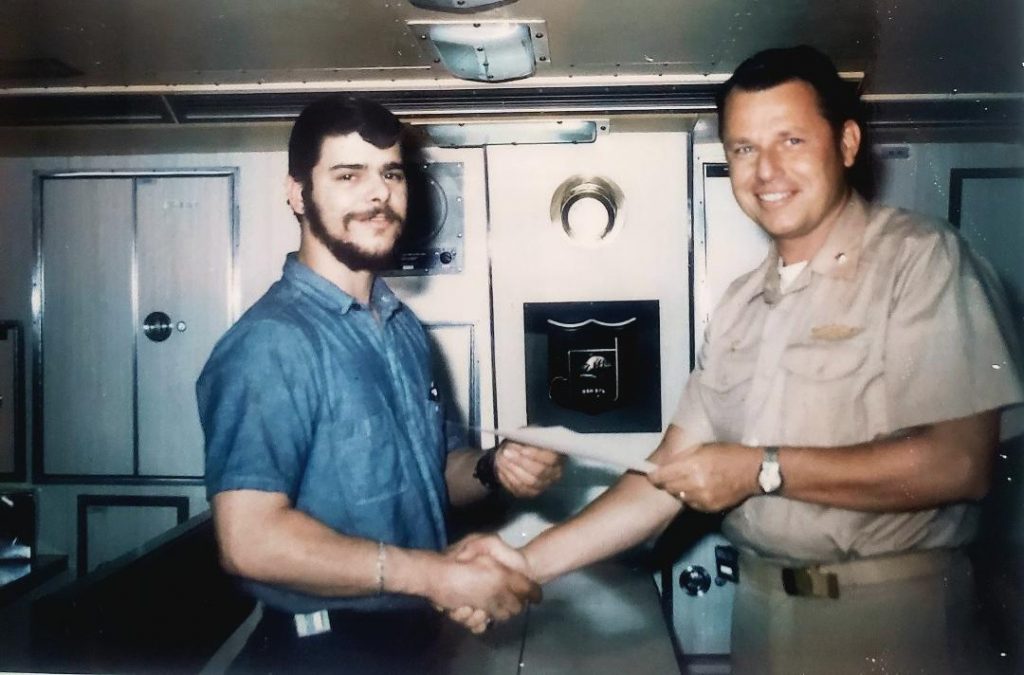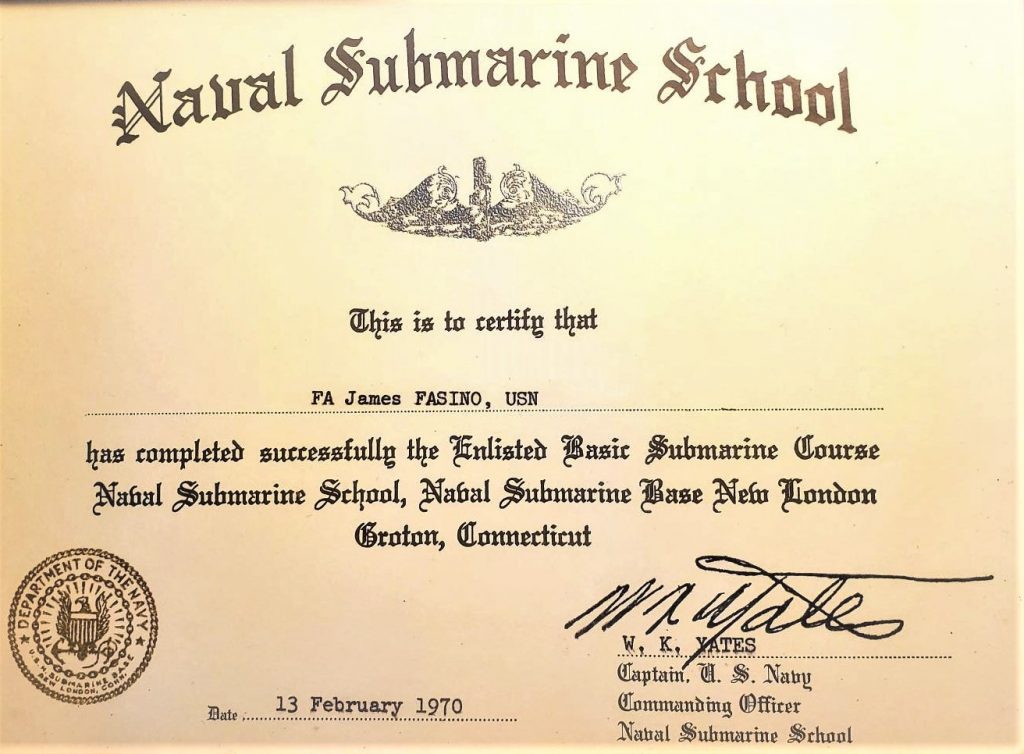
I’ve had a lifelong love for the United States Navy and the “The Silent Service” in particular, and serving there has been my proudest accomplishment. My patriotism for America is rooted in my childhood when mom would bring me to watch the parades on the avenue on national holidays where I’d see the tanks and caissons roll by escorted by soldiers, sailors, and Marines marching in lockstep with Old Glory and service banners cracking in the breeze. And as I sat on the curb and sensed the excitement of the ground trembling under their weight, I envisioned that someday I too would join the military and proudly wear the uniform of my beloved country.
Born in 1949 I grew up in the post war era of the 50s and 60s, a time of boundless nationalism and pride and I became engrossed in the war time Hollywood movies and TV shows like “Run Silent, Run Deep” and “The Enemy Below,” and “The Silent Service, and Navy Log”. Consequently, I developed a partiality toward the Submarine Service mostly because of the inherent risk and the comradery and intimacy of the small crews who seemed to be a bawdy lot who would back each other through thick and thin inciting my desire to someday join the Navy and become a submariner.

I was living the typical teenage lifestyle when at 16 tragedy struck my family when my dad took ill and died suddenly due to an undiagnosed disease that had been lingering for years. He was just 49 years old and the loss turned my life upside down, I lost all interest in school so I convinced my grieving mother to allow me to drop out of high school and go to work. But later on, I knew that it was a mistake that I must rectify one day.
It was the Viet Nam war era and soon after, at 19 I received my military induction notice in the mail. But my vision of becoming a submariner hadn’t diminished so I followed through with my original plan and made a visit to the local Navy recruiter. But, after finishing the entrance exam he informed me that because I wasn’t a HS grad he couldn’t guarantee me any training at all but based on my high score that he was confident that I could volunteer for submarine duty in boot and be accepted. So, I took him at his word and signed the enlistment papers. That was in May of 1969 just one year after the loss with all hands aboard of USS Scorpion SSN-589 and although I was well aware of that tragedy, I wasn’t deterred.
I had joined on a three-month delay program so on August 13, 1969 I boarded a plane from Newark New Jersey to Navy basic training at Great Lakes Illinois where I volunteered for submarine duty and after further testing and psychological screening, I was recommended to attend Basic Enlisted Submarine School at New London, Connecticut. Then after a two-week home leave, I reported in and the adventure began. All of us new candidates attended an orientation to hear the submarine school commandant deliver his welcoming speech. He opened by saying;
“Welcome to the United States Navy Submarine School, the only school of its kind in the world. You men sitting here today are among the top ten percent of the United States Navy, and if you are going to make it through this course and later-on out there in the fleet then you must give one hundred and ten percent of yourselves each and every day. Now, that tell that to the Marines, and they tell it to Navy fighter jock candidates; but we mean it!”

The course comprised ten weeks of intensive formal class work and training encompassing the design and operational characteristics of the then current 640-Class Fleet Ballistic Missile (FBM) submarine, the original “Forty-one for Freedom” boats. Should one fail any of the ten weekly exams up to and including the final then he was washed out, no questions asked and no makeups. The requirement was stringent but necessary because if one fouls-up aboard a submerged submarine there are no second chances; submarines operate in a hostile environment that allows zero tolerance for incompetence, so the junior most man can make an error that results in the loss of the ship and kill the entire crew.
The following day was our opening class day and the instructor, a submarine qualified chief petty officer, outlined the course curriculum that included, nuclear reactor operating theory, propulsion, electronics, electricity generation, pneumatics, hydraulics, ventilation, weapon systems, sonar and radar systems, electronic counter-measures, periscopes and masts, ballast and trim control, emergency first aid, and much, more. After class when I returned to the barracks, I sat atop my bunk stunned by the amount of information that I would have to ingest, memorize and then be tested on prompting me to become filled with self-doubt. And as I looked around the barracks, I thought that all these guys were probably HS graduates and that maybe I had missed too much, maybe I didn’t belong here. But then, I resolved that I would do whatever it took to make it through this school and become a submariner; failure was not an option.
In the days that followed my young classmates bonded together and we formed study groups and stayed up late at night sitting in our skivvies and tees on the cold hard wood floor of the barracks cramming for exams, eating pizza, drinking coke, and learning and laughing together. And, as the weeks passed and we said our goodbyes to the washouts we each pondered if we would be next. In the end 48% of the hand selected candidates in our class washed out due to academic, physical or psychological reasons.
Besides academics, we were subjected to psychological and physical challenges that the failure of any one of meant immediate dismissal from the course. They included a submarine control room and diving station simulator, a damage control trainer, a firefighting trainer, a toxic gas trainer, a decompression chamber, and the renowned and dreaded submarine escape training tank that reached 119 feet into the New England sky where every perspective submariner had to successfully complete a free ascent from the 50-foot level without the aid of breathing apparatus. It was the last test following the final written exam, so if one succeeded then he knew immediately that he was in and so hit the surface with a resounding exclamation of glee and excitement and yelling the required phrase “I feel fine sir!”. But successfully completing Submarine School was just the beginning because one now had to complete a ten month on the job training program and pass a qualification board in order to earn the coveted submariner dolphin’s chest pin to become a full-fledged and anointed USN submariner, a designation he holds and covets for life. Submarine training is some of the most rigorous in the U.S. military and to be called a submariner is truly a badge of honor that grants one a lifetime membership the elite association of the “Brothers of the Phin” (Dolphin).
While in Submarine School I saw a posting on a bulletin board that read “Get Your GED” so I took the five required tests over two days and scored a high enough percentile grade to earn my home state of New Jersey’s official GED certificate. This small accomplishment that I achieved, really on a whim, would have huge and positive implications on my future life.
After graduation, orders were issued according to class academic ranking and I was ranked 13th among the surviving 80 candidates and I received orders to the pre-commissioning crew of the nuclear Fast Attack submarine USS Bluefish SSN-675 that was currently under construction at the General Dynamics Electric Boat (GDEB) shipyard just down river from the base. Subsequently after our crew had succeeded in bringing Bluefish through her sea trials, accepting her for the Navy and putting her into commission at the Sub-Base it was on to Norfolk our new home port. I eventually became qualified in submarines, was awarded my silver dolphins and became a Torpedoman, the small arms Petty Officer and a Nuclear Weapons Handling Supervisor among other responsibilities.
I left the Navy into the dismal recession plagued economy of 1973 where jobs were tough and gasoline lines were long due to the OPEC oil embargo. I worked numerous jobs but most were either dismal, dead ended, or resulted in layoffs. But finally, I landed an entry level position at a machinery design and manufacturing firm and over the next 20 years worked my way up the ladder to be an application engineer while I also put myself through college part time under the GI Bill and earned a BA degree with a Major concentration in Broadcasting and Journalism. Next, I began to try to break in as a broadcast TV cameraman and my first big break came when I was hired to work horse racing at the Meadowlands Sports Complex where I also worked pro sports games for the NFL NY Giants, NBA NJ Nets, and NHL NJ Devils. And soon my TV career blossomed and I was working free-lance gigs all over NYC and NJ in pro and college sports and at all the major cable network news channels. Eventually I became proficient in working every type of camera, including hand-held, studio, jibs, and robotic camera systems too. One of my clients was the United Nations and after free-lancing there for a time I was hired to a staff News cameraman position at UN headquarters in NYC. I’m now semi-retired and a free-lance writer living on Myrtle Beach.
Working in the broadcast industry was a fun and exciting time in my life and over the course of my TV career I’ve worked in many high security situations and with hundreds of pro sports figures, Hollywood celebrities and high-profile politicians including five U.S. Presidents and First ladies, Kings, Queens, Shahs, and nearly 200 heads of states of UN member countries. I’ve even worked with Fidel Castro once. And, I was involved in the tragic events of 911 when I was assigned to record the evacuation of the UN complex and saw my friends and colleagues exiting the building in shock and with expressions of horror on their faces. But, none of the success I’ve enjoyed in my chosen field would have ensued had it not been for the Submarine Service, therefore I have a deep love and appreciation for it because being afforded that first opportunity changed the course of my life for the better. I even stumbled upon my retirement home because I attended a USS Bluefish crew reunion in Myrtle Beach at the resort that I now live in, and I wrote my first published freelance article for LIBW concerning my first dive on a submarine. So, the Navy has been a constant companion in my life and truly it’s not about what I did for the Navy but rather what the Navy has done for me. I entered it as an emotionally wounded and aimless teenager and through their training and confidence in me I exited as a mature and skilled young man; I grew up in the Submarine Service and was mentored by the types of men who were my childhood heroes. And I’ve had a longing to thank someone for what it has done for me. So, I guess writing this story is my expression of gratitude. So, thank you United States Navy and all the men that I had the privilege and honor to serve with in the Silent Service.
“I can imagine no more rewarding a career.
And any man who may be asked in this century what he did to make his life worthwhile,
I think can respond with a good deal of pride and satisfaction:
‘I served in the United States Navy.”
President John F. Kennedy
